By Troopship to the Far East
If in the 1950’s you were posted abroad, there was a good chance that you’d be conveyed to your destination by troopship. With world-wide commitments and large numbers of troops based in many parts of the world, the most economical method of getting lots of servicemen to where they were wanted was by troopship. Which is what happed to me in the mid-1950’s when I was conveyed to and from the Far East by the British India Steam Navigation troopship the SS Nevasa.
A little research shows that the Nevasa that was built in 1956 as a troopship to government specifications and despite being operated by the British India Steam Navigation line she sported a buff coloured funnel rather than the normal B.I. black funnel with two white bands.
The Nevasa had a tonnage of 20,527 tons with accommodation for 220 1st class pax, 110 2nd class, 180 3rd class and 1,000 troops on the troop decks.
A similar troopship, the SS Oxfordshire was also in service at this time operated by the Bibby Line.
My journey to the Far East in October 1956 was only the Nevasa’s second voyage; her maiden voyage had been to Malta. Nevasa served as a troopship from 1956 to 1962, but as National Service came to an end in the early 1960s and air transport became more efficient, troopships were made redundant, the last troopship voyage being made in December 1962 by the SS Oxfordshire to Malta. OK the Uganda and QE II were used in the Falklands campaign, but they weren’t designed as troopships.
In 1956 I was with Fighter Command Communications Squadron based at RAF Bovingdon near Hemel Hempstead in Hertfordshire. In July 1956 I received the standard PWR (Preliminary Warning Role) letter notifying me that I had been selected for posting to the Far East Air Force (FEAF) and that I was to report to number 5PDU at RAF Innsworth in Gloucestershire to be kitted out for my posting. Departure date from Southampton was scheduled for 19th of August 1956 on the SS Nevasa. In the event, with the Suez crisis in full swing and the closure of the Suez Canal the planned sailing date was postponed to an undecided future date. With the Canal closed we were told that we would be travelling on the ‘long’ route around the Cape of Good Hope and we were to remain at RAF Innsworth pending a new departure date.

My record of service showing the 'blip' in my posting to the Far East.
Having been kitted out with tropical kit and received our overseas jabs we hung around Innsworth for about two weeks, but with no departure date set for the voyage we were sent home on leave for about six weeks, being told that once a firm departure date had been decided we’d receive a letter or telegram advising us when we had to return to Innsworth.
With six weeks advance pay jangling in my pocket I went home.
Six weeks of absolutely nothing to do on paid leave at home was quite splendid, I saw my girlfriend again — we’d already said our tearful farewells and here I was back again! So we went dancing and had a week by the sea at Clacton. Whilst at Clacton I was amazed at the constant procession along the main roads of convoys of army vehicles towing guns, all with newly applied sand-coloured desert camouflage as they proceeded to east coast ports for loading on vessels to be transported to the Middle East.
Rather enjoying life I spent a further few weeks saying further prolonged farewells to all my family and friends and had a rather good time at the taxpayer’s expense! The call-forward letter eventually arrived and I returned to Innsworth, the R.A.F. draft for the Far East was bussed down to Southampton where we embarked on the British India troopship ‘Nevasa’ — we sailed on the 16th of October 1956.
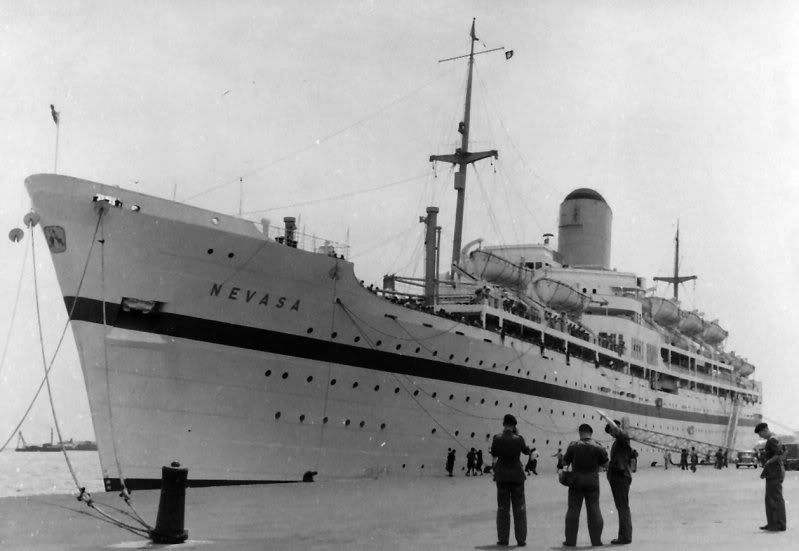
Nevasa at Southampton Docks - Oct 1956
Five years earlier in 1951, as a newly conscripted RAF recruit I was posted to the then Southern Rhodesia for service with 5 FTS (R.A.F. Thornhill) in the Rhodesian Air Training Group, the journey in those days being by sea as Cabin Class passengers on Union Castle Line liners from Southampton to Cape Town. Having already travelled by sea, albeit on an ocean liner (the RMS “Edinburgh Castle”) as a Cabin Class passenger, I had vague hopes that the Nevasa, reputably a modern troopship, would provide similar standards of comfort; sadly for us lower ranks the opposite was true, the voyage turned out to be one of the most uncomfortable and boring journeys I’ve ever made. Joining the Nevasa at Southampton the rumour was that because of the closure of the Suez Canal the Nevasa would be carrying up to twice the normal number of service personnel, in retrospect probably an exaggeration, but we were certainly carrying far more than the designed complement of troops. It was obvious when we embarked that the journey was not going to be anything like my fondly remembered comfortable passenger liner voyage. The bunks in the troop decks, normally three tiers high, had been rearranged by squeezing in an additional tier making four in all which meant that the space was so cramped that if one wanted to turn round in the bunk it could only be done by climbing out of the bunk and getting back in again.
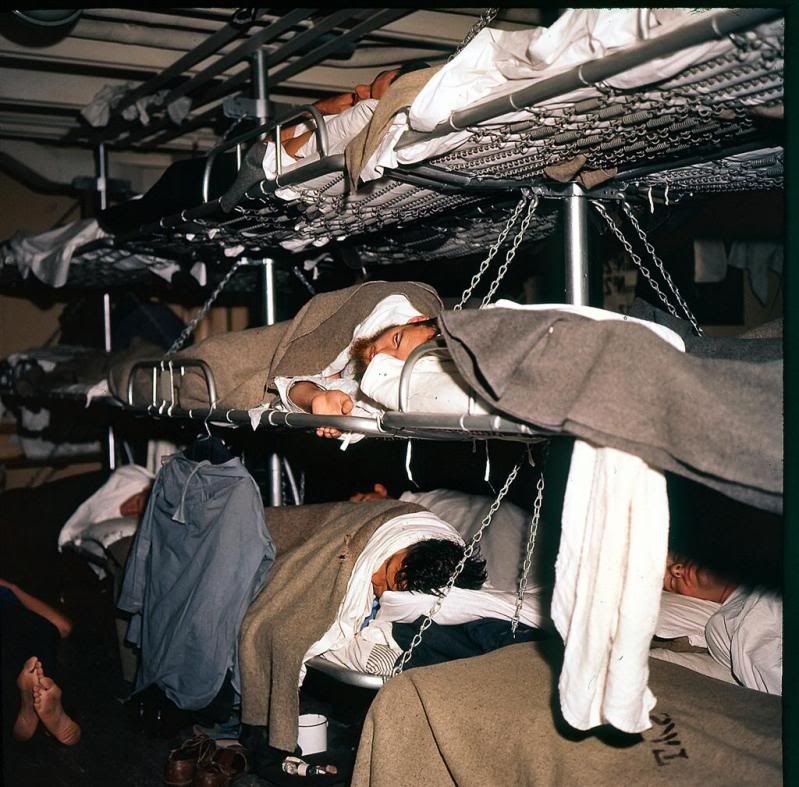
This picture of the bunks on the troop deck was taken two year's later and shows standard 3-tier layout. On the way out in 1956 an extra tier had been added.
On our troop deck near the bow, the toilets were designed for about half the number of men being carried and a queue regularly formed to use them. Both showers and wash basins were fed by salt water, and the so called “salt-water” soap that we were given was a joke; there was just no way one could raise a lather with it to make oneself clean. There was one water fountain fed by fresh water which we used to clean our teeth.
During the voyage we ran into two quite severe storms, the first as we left Southampton lasted for about three days as we passed through the Bay of Biscay; the second was off the west coast of Africa in the South Atlantic. For most troops on board the first storm was a major upset, and nearly all were violently seasick. The packed bunks meant those on the bottom tiers were regularly regurgitated on by those above which was most unpleasant, one poor soul never really gained his sea-legs and was sick for most of the one-month long voyage. My memory of the food on board is that it was reasonable but not anything to really write home about; with so many to cater for the meals had to be taken in three separate half-hour sittings.

The outdoor deck screen
Apart from the occasional film, entertainment was virtually non-existent, when we reached the tropics films were shown on the open foredeck but with no seats we sat crossed-legged on the wooden deck and made our self as comfortable as possible. Being in the open the occasional tropical shower would terminate the performance, a memorable experience for all the wrong reasons!
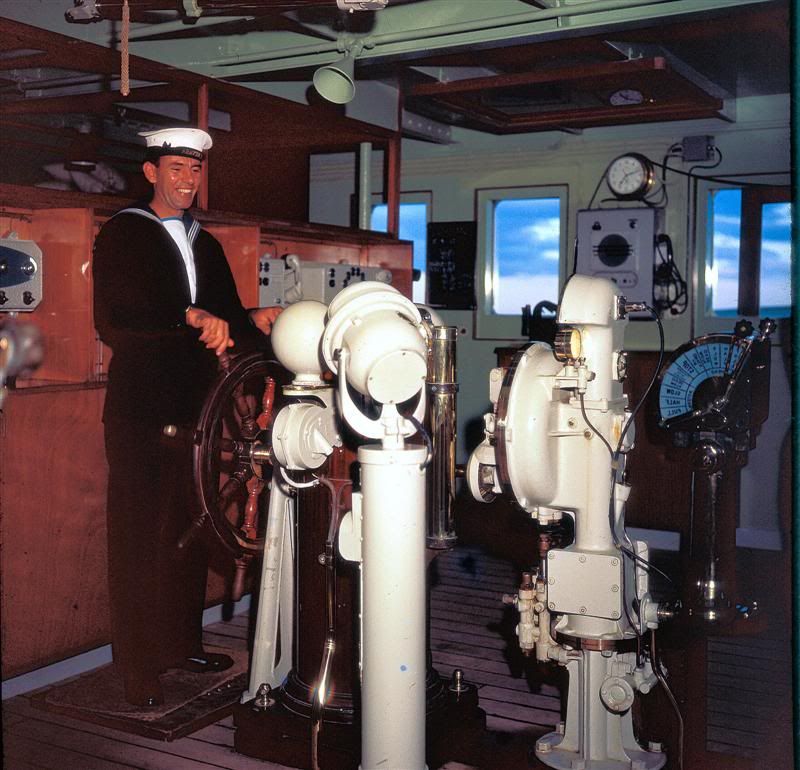
We were invited to visit the bridge and couln't resist taunting the helmsman with 'The Navy Lark' catch phrase "Left hand down a bit!"
During the day we were required to do physical exercise on deck, with the army drill instructor shouting at us if we weren’t up to his ideal of physical perfection. Deck games were organised with team competitions between the various services and we also were taken to the rear of the ship and given a .303 rifle and invited to shoot at balloons that had been thrown into the water for target practice.
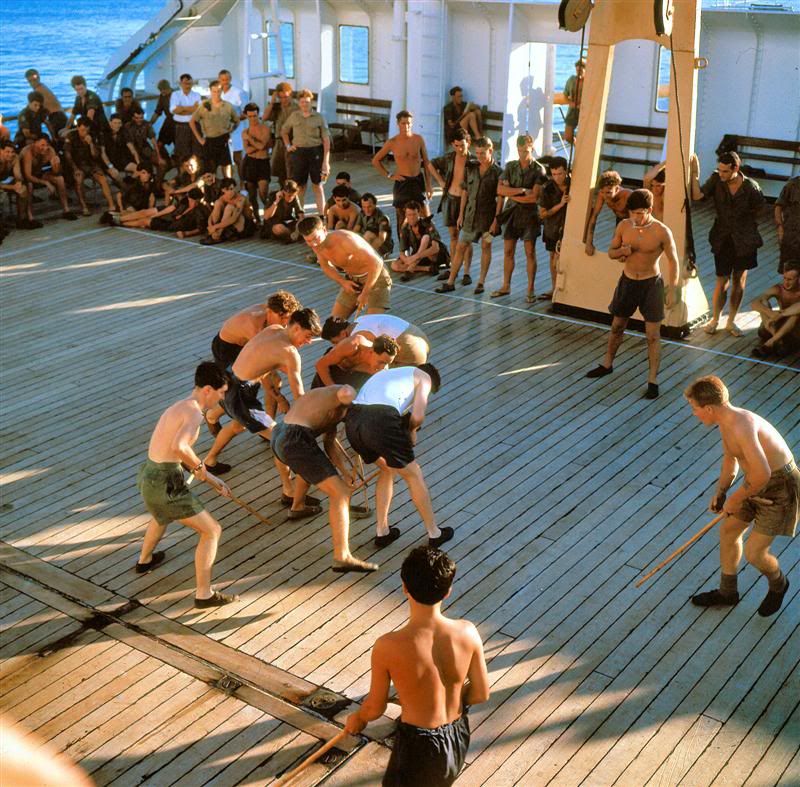
Inter Service Deck Games.
With the Suez Canal closed the long round the Cape route to the Far East meant stops in unfamiliar ports. We had a very short stop at Las Palmas in the Canary Islands to take on food and provisions; we were allowed to stretch our legs on the quayside but were forbidden from going into town. The next stop was Dakar in Senegal, at the time a French colony, civilised and a nice place to unwind, although we were only allowed ashore during the day.
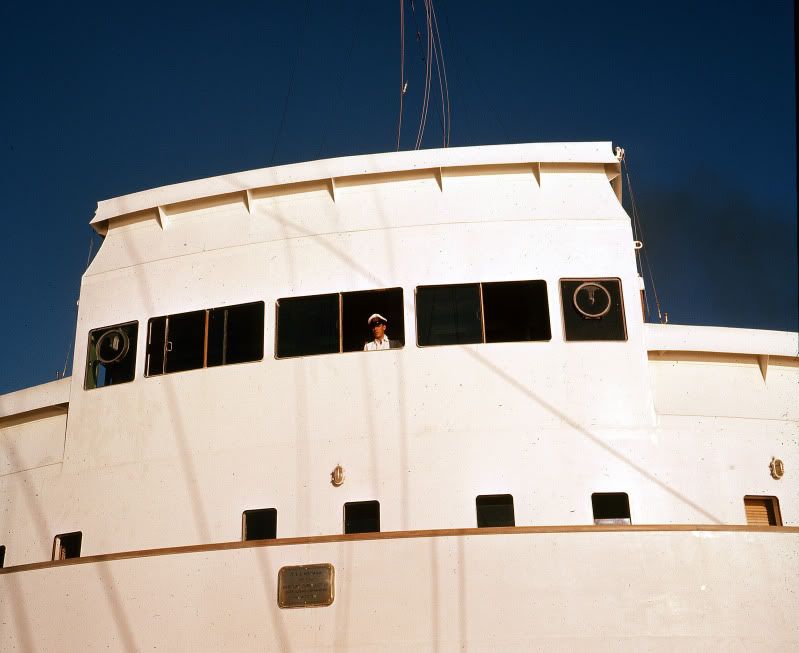
Nevasa - The Bridge
Dakar allowed me to stock up with some Ektachrome colour 120 film for my reflex camera, which in 1956 was virtually unobtainable in the UK without a special licence.

This photo was taken somewere south of Dakar with my newly acquired colour film and shows how white we all were as we tried to get our knees brown!
Having left Dakar our next stop was Durban in South Africa. Between Dakar and Durban the ship’s supply of beer ran out, which was pretty disastrous. Sailing down the west coast of Africa towards the Cape, we ran into a severe South Atlantic storm, so much is so that the boat’s hull was regularly lifted out of the water and came down with an enormous great crash which reverberated throughout the ship, being in the bow we experienced it the most, this weather lasted for about three days. Having rounded the Cape and heading north along the east coast of South Africa towards Durban the weather abated, and we enjoyed a quieter couple of days.

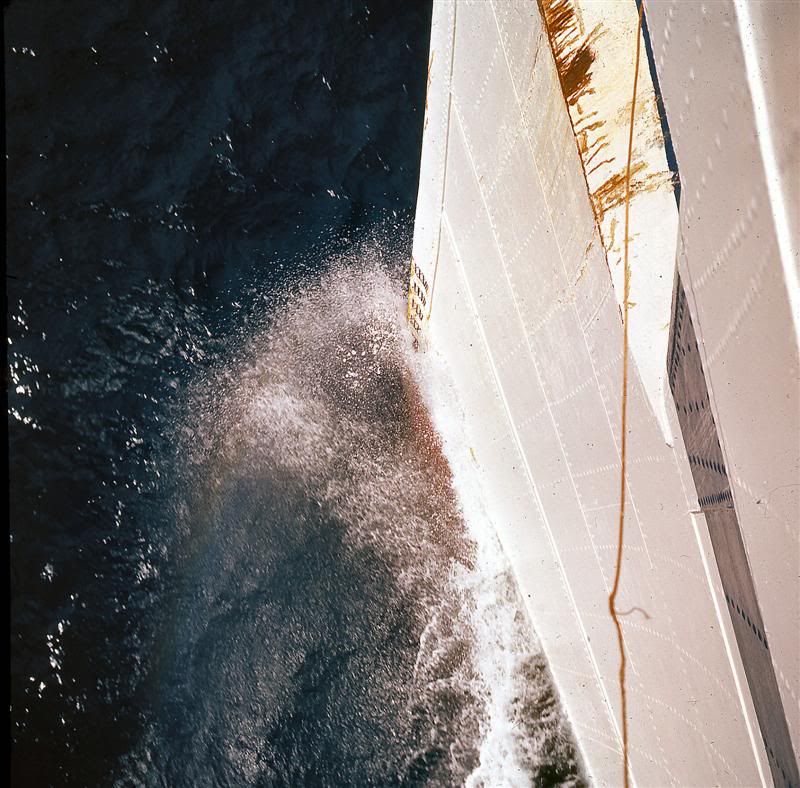
At Durban, we were allowed ashore for the day and evening, with orders to be back on board by midnight. I spent the day sightseeing, swam and tried surfing in the Indian Ocean and in the evening visited the Durban branch of the Royal Air Force Association which was situated in a posh area of town. The RAFA locals were so generous I don’t think any of the RAF servicemen who went for a drink at their club that evening had to pay for anything.
We departed Durban early the next morning and as we passed slowly out of the harbour towards the sea we were greeted by Mrs. Perla Gibson the ‘lady in white’, standing at the end of the northern breakwater and singing through her megaphone and waving to us, we could still see her waving, long after the sound of her voice had faded. The ‘lady in white’ was a wartime legend who sang to the troops as they left harbour on their journey to the battlefields of the Middle and Far East. When we arrived in Durban in 1956, the war had been over for 11 years, but still this lady knew we were coming and sang to us farewell greetings to speed us on our way.
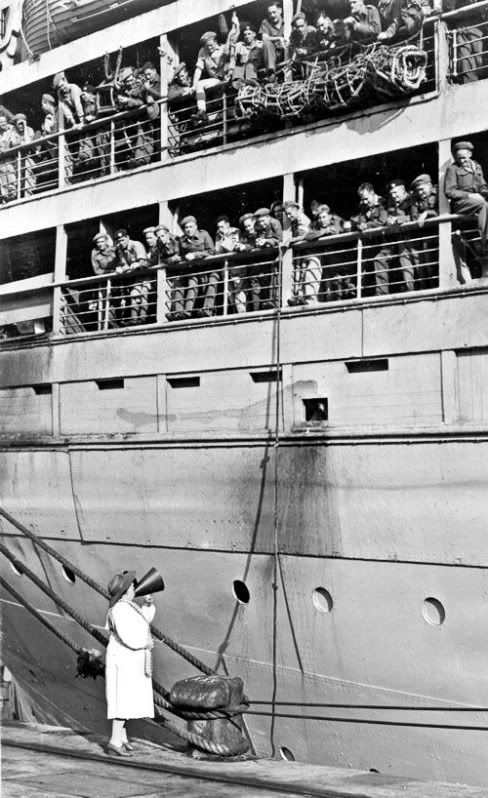
The Lady in White - War Time Photo
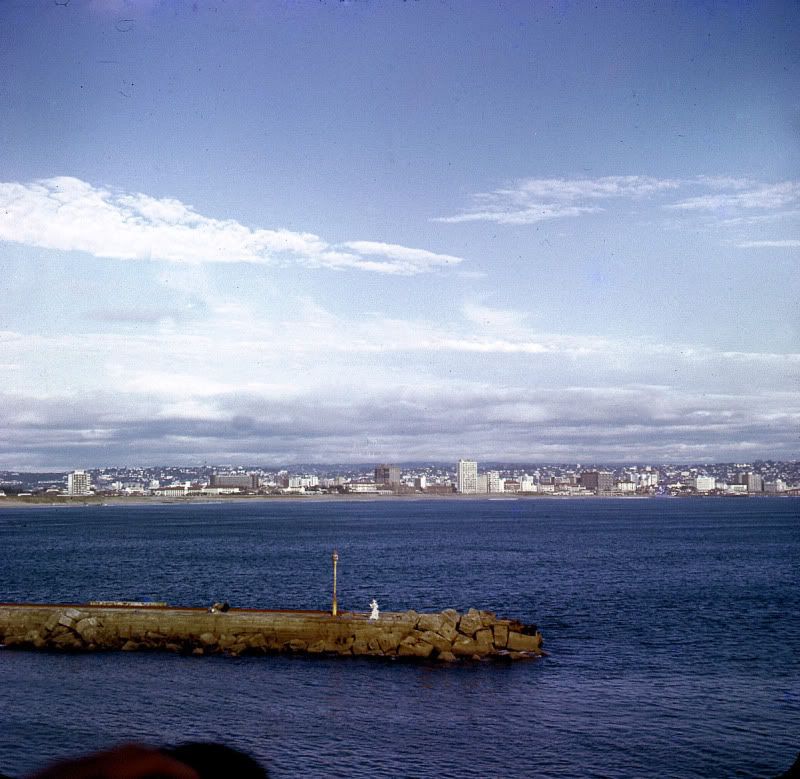
The Lady in White on the North Pier Durban October 1956
Leaving Durban, we headed northeast across the Indian Ocean towards the northern tip of Sumatra, passing the French island of Reunion on the way. Going around the northern trip of Sumatra we were astonished to see enormous numbers of sea snakes swimming in the sea. Eventually, about twelve-days later on 15th of November 1956 the Nevasa dropped anchor at Singapore. Pax for Singapore, Malaya and Ceylon disembarked and the Nevasa continued her voyage onwards to Hong Kong and Korea.

I spent a week at RAF Changi waiting for a flight to my FEAF posting at RAF Negombo in Ceylon and whilst in Singapore took this photo on the Esplanade.
More to come